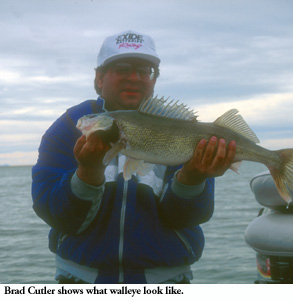
Foul Weather Walleye Fishing
 By
Ron Stewart, DWR Information Officer
By
Ron Stewart, DWR Information Officer
Do you like to stay up all night with a couple of good friends? Do you think staying up all night and bouncing around in a little boat with gale force winds trying to crash you into the rocks is fun? Then walleye fishing is definitely for you.
According to the experts, the best times and the best places to fish for walleye are the times and places most people with even a little common sense avoid. Windy, black nights, icy drizzle and white-capped waves crashing into a rocky shoreline — yep, perfect walleye fishing!
Why would anyone fish under these conditions? It's not because of the great fight walleye put up when hooked. In fact, walleye often let you bring them right in close to the boat before fighting back. Even then it's not really a fight, more of a panic. So why brave the elements to catch them? Walleye are considered by many to be the tastiest of all freshwater fish.
There are many techniques used to catch walleye, principally: jigging baits or lures, casting or trolling crank baits, casting or trolling shallow, floating or diving plugs, and using a slip sinker bait rig to float a night crawler or minnow just above the bottom. For all of the above methods, eight pound test line and a light to medium action rod are essential equipment. Graphite or other composite rods, capable of sensing even the slightest nudge, work the best. Walleye are notorious for their light taps which are easily mistaken for weeds.
Jigging is the odds-on favorite of most walleye fishermen, especially once they get to know a lake. Jigs can be simple, plain leadheads or fancy bucktail and paint combinations. A simple lead jig hooked through a minnow, a curly-tailed grub or a worin works well and can be the least expensive method when you consider the number of lures lost to snags.
Many fishermen hook the jig through the lips of the minnow, for optimum flash and flutter, but with walleye a more solid attachment is probably better. Thread the hook through the minnow's mouth and out the gills, then push the niinnow up against the lead jig head and push the hook through the belly and out its back. The jigging motion of the retrieve gives the minnow all the action it needs. Remember, transporting and using live minnows for bait is illegal in Utah.
Jigs should be bounced along the bottom. Fish the structures, rocks, brush and logs (especially near dropoffs), dam faces, river mouths and rocky points. Pay special attention as the jig drops because any light interruption could be a walleye.
Crank baits and floating or sinking plugs can also be effective all year round. It's best to have a wide selection of these lures. Most should be in the three-and-a-half to four-and-a-half inch range. Carry a few bigger or smaller models as well. Silver and gold colors are good producers, but sometimes the fish prefer fluorescent or natural colors.
Trolling crank baits or plugs and alternating colors, styles and depths is a good way to get to know a lake. Again, the best places to fish are over the bottom structures. A good topographic map can help place these structures, as will a fish finder. Look for submerged islands or timber, drop-offs, weed beds and mud flats near spawning areas. Crank baits and plugs can also be cast from boat or shore. Once a site is found, anchoring off the spot and casting often gives the best results.
Walleye are most active at night. During the day, they often lay under ledges and in weeds and don't move around much. They start moving around at dusk and can be caught any hour of the night. At dawn, they move back under the ledges and other cover to avoid sunlight. During the spring and fall, when the weather is cool, they are often found near the surface. During the summer months they move deeper, avoiding the warmer surface waters.
Walleye may be taken during the day if a lure is presented just right. Walleye generally ambush their prey so a lure that flutters right in front of them may be taken anytime. Since they hide from the sun, the best places to find fish during the day are in the shadows and in stained or muddy waters. Murky, windswept points are often productive during the day.
Still, the best fishing seems to be during the worst conditions. If it has been windy for several days and white caps have been pounding one shoreline, that is where you want to be. Somewhere along that shoreline the walleye will be congregating for dinner. If you can brave the elements long enough to locate the school, you will find good, fast fishing.
Walleye lakes in Utah include: Starvation, Deer Creek and Yuba reservoirs, Utah Lake, Lake Powell and Willard Bay. Walleye attract the most attention during their annual spawning run, which generally begins in late April and runs through May. The run begins a bit later in Starvation. But walleye can be taken year-round. Fishing is usually good but spotty through the summer and then picks up a bit in the fall as the water temperature starts to cool.
Copyright Dave Webb, 2005